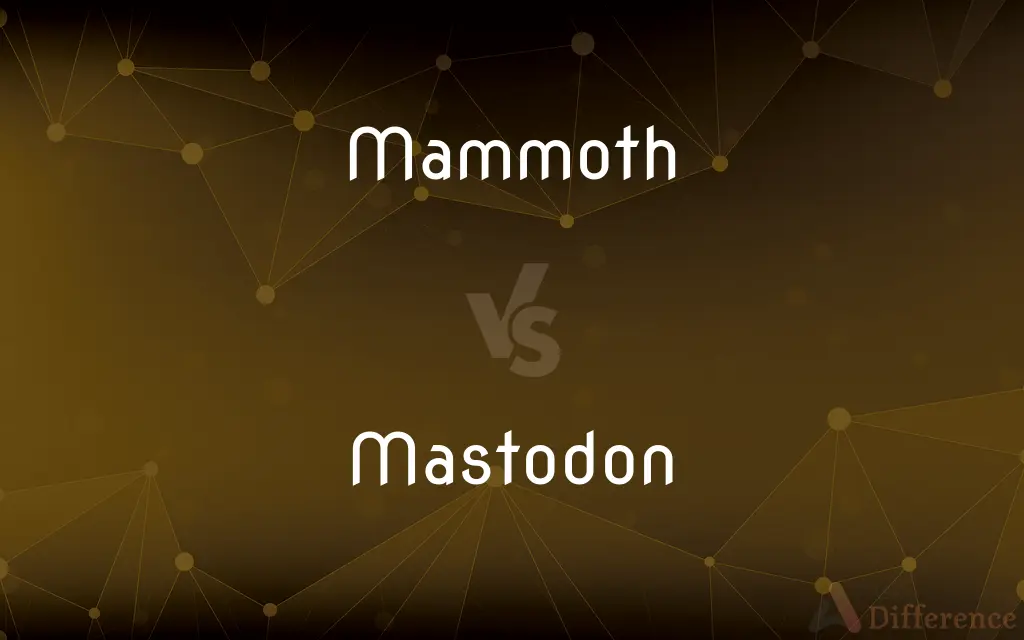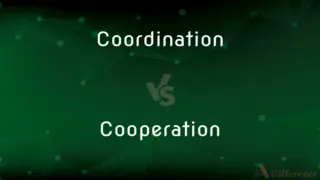Mammoth vs. Mastodon — What's the Difference?
By Tayyaba Rehman — Updated on September 22, 2023
Mammoths are ancient, hairy elephants with long, curved tusks, while Mastodons, another prehistoric relative, have straighter, shorter tusks and more conical teeth. Both lived during different epochs and varied in size and habitat.

Difference Between Mammoth and Mastodon
Table of Contents
ADVERTISEMENT
Key Differences
Mammoths and Mastodons are both prehistoric proboscideans, but they belong to different genera. The Mammoth is known for its iconic long, curved tusks and thick, shaggy hair. These adaptations helped them survive in the colder regions, particularly during the Ice Age. Their molars were plate-like, allowing them to graze on grasses.
On the other hand, Mastodons had shorter, straighter tusks. Their name "Mastodon" translates to "breast tooth" due to the teat-like projections on their molars, which made them more suited for browsing on shrubs and trees. Unlike the Mammoth, which roamed open grasslands, the Mastodon typically lived in forests or swampy areas.
Another significant difference between the Mammoth and the Mastodon is their temporal existence. While there were overlaps, Mastodons appeared earlier in history. Some of the earliest Mastodons lived around 27 million years ago, while the first Mammoths appeared about 5 million years ago.
In essence, although Mammoths and Mastodons might seem similar due to their massive size and tusks, they were distinct species with different physical characteristics, dietary preferences, habitats, and time periods of existence.
Comparison Chart
Physical Traits
Long, curved tusks; thick, shaggy hair.
Shorter, straighter tusks; less hair.
ADVERTISEMENT
Teeth
Plate-like molars for grazing on grasses.
Conical molars for browsing on shrubs and trees.
Habitat
Open grasslands.
Forests or swampy areas.
Time Period
Appeared around 5 million years ago.
Some of the earliest appeared around 27 million years ago
Size & Build
Generally larger and more slender.
More robust and stout.
Compare with Definitions
Mammoth
A large, extinct elephant species with long, curved tusks.
The woolly Mammoth roamed the icy tundras during the last Ice Age.
Mastodon
A creature known for its conical molars suited for browsing.
The Mastodon's teeth are distinctly different from those of a Mammoth.
Mammoth
A term denoting immense size or magnitude.
The construction project was a Mammoth undertaking for the small company.
Mastodon
An extinct, large mammal related to the elephant with straight tusks.
The Mastodon fossils suggest they lived in forested regions.
Mammoth
An animal adapted to cold environments with its thick fur.
The remains of a Mammoth were discovered perfectly preserved in Siberian ice.
Mastodon
An animal that existed in a time frame earlier than the Mammoth.
The Mastodon lived millions of years before the woolly Mammoth.
Mammoth
An iconic representation of the Ice Age fauna.
The museum's Mammoth exhibit attracts thousands of visitors.
Mastodon
A term sometimes mistakenly used interchangeably with Mammoth.
Many people confuse the Mastodon with its more famous cousin, the Mammoth.
Mammoth
A mammoth is any species of the extinct elephantid genus Mammuthus, one of the many genera that make up the order of trunked mammals called proboscideans. The various species of mammoth were commonly equipped with long, curved tusks and, in northern species, a covering of long hair.
Mastodon
A representation of pre-Ice Age fauna.
The Mastodon is often overshadowed in popular culture by the woolly Mammoth.
Mammoth
Any of various extinct elephants of the genus Mammuthus of the Pliocene, Pleistocene, and Holocene Epochs, having ridged molars and often, as in the woolly mammoth, long tusks and hair.
Mastodon
A mastodon (mastós 'breast' + odoús 'tooth') is any proboscidean belonging to the extinct genus Mammut (family Mammutidae) that inhabited North and Central America during the late Miocene or late Pliocene up to their extinction at the end of the Pleistocene 10,000 to 11,000 years ago. Mastodons lived in herds and were predominantly forest-dwelling animals that lived on a mixed diet obtained by browsing and grazing, somewhat similar to their distant relatives, modern elephants, but probably with greater emphasis on browsing.
Mammoth
Something that is of great size.
Mastodon
Any of several very large, extinct proboscidian mammals of the family Mammutidae of the Miocene, Pliocene, and Pleistocene Epochs, resembling elephants but having molar teeth of a different structure.
Mammoth
Of enormous size, extent, or amount; huge.
Mastodon
Extinct elephant-like mammal of the genus †Mammut that flourished worldwide from Miocene through Pleistocene times; differs from elephants and mammoths in the form of the molar teeth.
Mammoth
Of great scope or importance
Mammoth expectations.
Mastodon
(figurative) Anything big or clunky.
Mammoth
Any species of the extinct genus Mammuthus, of large, usually hairy, elephant-like mammals with long curved tusks and an inclined back, which became extinct with the last retreat of ice age glaciers during the late Pleistocene period, and are known from fossils, frozen carcasses, and Paleolithic cave paintings found in North America and Eurasia.
Mastodon
An extinct genus of mammals closely allied to the elephant, but having less complex molar teeth, and often a pair of lower, as well as upper, tusks, which are incisor teeth. The species were mostly larger than elephants, and their remains occur in nearly all parts of the world in deposits ranging from Miocene to late Quaternary time.
Mammoth
(obsolete) A mastodon.
Mastodon
Extinct elephant-like mammal that flourished worldwide from Miocene through Pleistocene times; differ from mammoths in the form of the molar teeth
Mammoth
(figuratively) Something very large of its kind.
Mammoth
Comparable to a mammoth in its size; very large, huge, gigantic.
Mammoth
An extinct, hairy, maned elephant (Mammuthus primigenius formerly Elephas primigenius), of enormous size, remains of which are found in the northern parts of both continents. The last of the race, in Europe, were coeval with prehistoric man.
Mammoth
Resembling the mammoth in size; very large; gigantic; as, a mammoth ox.
Mammoth
Any of numerous extinct elephants widely distributed in the Pleistocene; extremely large with hairy coats and long upcurved tusks
Mammoth
So exceedingly large or extensive as to suggest a giant or mammoth;
A gigantic redwood
Gigantic disappointment
A mammoth ship
A mammoth multinational corporation
Mammoth
A creature resembling modern-day elephants but adapted to ancient climates.
Artifacts from ancient cultures often depict the Mammoth in their drawings.
Common Curiosities
Are Mammoths and Mastodons ancestors of modern elephants?
They are relatives, but modern elephants evolved from different ancestral lines.
Why did Mammoths and Mastodons go extinct?
Multiple factors like climate change and human hunting contributed to their extinction.
Were both Mammoths and Mastodons hairy?
While Mammoths are famously known for their fur, not all Mastodons were as hairy.
Which was bigger, the Mammoth or the Mastodon?
Generally, Mammoths were larger, but size varied among species.
Did Mammoths and Mastodons coexist?
Yes, there were periods when both species coexisted, though Mastodons appeared earlier.
Where are most Mammoth fossils found?
Many have been found in Siberia and North America.
Were Mammoths and Mastodons carnivorous?
No, both were herbivores but had different dietary preferences.
Can we clone Mammoths or Mastodons using their DNA?
The concept is debated, but as of now, there's no successful cloning of these creatures.
Did Mastodons have trunk-like modern elephants?
Yes, both Mammoths and Mastodons had trunks.
Which is more popular in pop culture, Mammoth or Mastodon?
The Mammoth, especially the woolly variety, is more iconic in pop culture.
Share Your Discovery

Previous Comparison
Nonprofessional vs. Unprofessional
Next Comparison
Coordination vs. CooperationAuthor Spotlight
Written by
Tayyaba RehmanTayyaba Rehman is a distinguished writer, currently serving as a primary contributor to askdifference.com. As a researcher in semantics and etymology, Tayyaba's passion for the complexity of languages and their distinctions has found a perfect home on the platform. Tayyaba delves into the intricacies of language, distinguishing between commonly confused words and phrases, thereby providing clarity for readers worldwide.














































